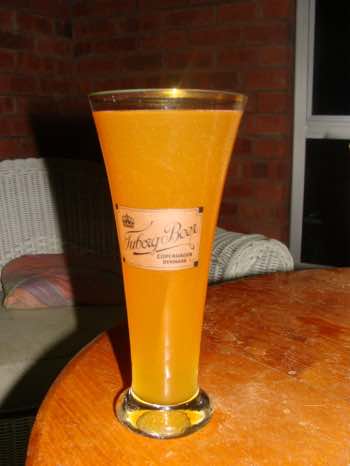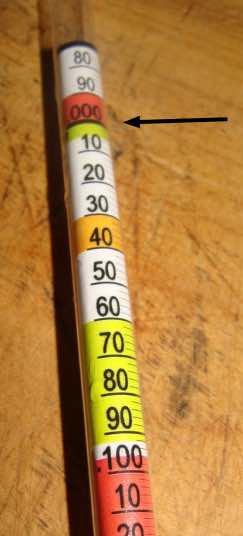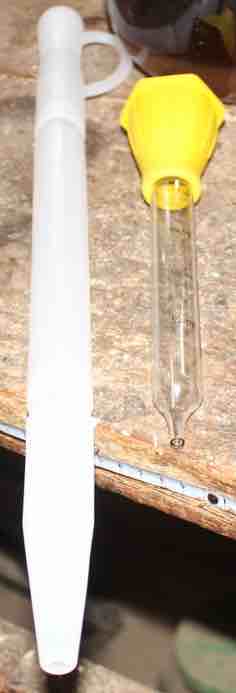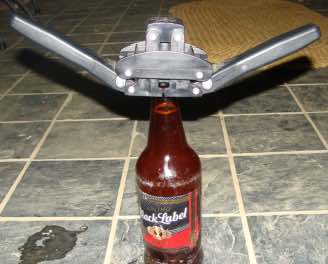- Bernard Preston homepage
- Beekeeping
- Honey Brown Beer
Honey brown beer
Honey brown beer is not the slightest bit difficult to make using a brew-kit; from scratch it's another ballgame. If you have your own hives then the cost is about half of that from the liquor store; and fifty times as nice. The most difficult step is the methodical sterilising of your bottles.
The larger the bottle the better as that is where much of the time and effort go. But it does create a problem as you will probably drink more.
It takes as much time to clean, sterilise and cap a one-litre bottle as another of say 350 ml.

Braggot
Geoffrey Chaucer writing more than six-hundred years ago was the first known author to call it a braggot. Certainly it is likely that honey brown beer like mead went back long before that time.
A braggot is to beer what mead is to wine; they both ferment the sugars in honey to alcohol and take us back into the mists of time.
Interestingly Pliny the Elder wrote nearly two thousand years ago that the British drank large amounts of a honey-brew; that could have been a mead or a braggot.
Beer kit
I have no experience of making it from basic principles but I have been brewing mead and a honey brown beer from a kit for many years. You can be enjoying your braggot after a week, though it is far better if you can be patient for a couple months; but the wine really needs to mature for half a year at least; otherwise it is harsh like a cheap-whiskey.
Your beer kit contains hops and a malted barley extract.
You will need a plastic bucket or large glass carboy that will hold 25 or more litres. The lid must be tight, with a hole drilled for an airlock.
Also needed is a long-handled plastic stirring spoon and a hydrometer for measuring the specific gravity; there is no other assured way of being certain that fermentation is complete.
In the early days in my naivety I thought I could do without and bottled too soon. It was not pleasant having shrapnel flying through the air in the pantry when the glass burst; and a colossal mess.
A cool day
Choose a cool day when the temperature is below 20oC. If the wort goes above 22 degrees, unpleasant tasting esters are formed. Do not make your honey brown beer in midsummer unless you have a way of keeping it cold.
On the other hand if the temperature drops below about 12oC then fermentation will stop. Choosing the right weather to make your honey brown beer is critical.
Step one
Thoroughly sterilise the bucket, tap and plastic-spoon for one hour; and the hydrometer too.
Pour the sterilising-liquid into your clean, empty beer bottles; the larger the better. I use one litre.
Step two
Bring roughly three litres of spring or rainwater to the boil in a large stainless steel or enamel pot. Add the contents of your beer kit; stir with the long-handled plastic spoon.
Allow to simmer for fifteen-minutes.
Step three
Meanwhile thoroughly rinse out your bucket and half-fill with more very cold spring or rainwater; you really do not want any chlorine in there. Add a few trays of ice. The temperature of the boiling honey brown beer concentrate must be dropped as quickly as possible.
Place the pot of boiling concentrate into a large bucket of cold, running water. Stir your honey brown beer so that it will cool very quickly.
Step four
Pour about 2 kg of liquid honey into the cool water and stir vigorously to dissolve the sugars; actually crystallised works too.
You could drop in a piece of honeycomb provided each of the cells has been pricked; any pollen will act as a nutrient for the yeast.
Step five
Pour the now partially cooled concentrate into your fermentation bucket that is half-filled with cold spring water and the honey. This is known as the wort and the temperature really should be brought below 30oC in twenty minutes or less; allow to cool further.
With the lid on the bucket rock it vigorously back and forth for ten long minutes to incorporate as much air as possible into the wort; the first part of fermentation is aerobic. The same principle is used when brewing a mead or baking a sourdough loaf.
Add more cold water until you have made up sufficient to leave a gap of at least 50 mm above the wort. Stir vigorously to ensure most of the honey has dissolved.
Large bubbles will form once fermentation begins and some of your braggot may escape through the air-lock if you fill the bucket too much; it makes a mess.
Check the pH if you can; yeast has an ideal range from 3.8 to 4.5. Addition of a little food grade CaCO3, bicarb or lemon juice can be used to adjust the levels.
Step six
Taking beer hydrometer readings is very important to ensure that fermentation is complete; sometimes the process temporarily slows and you may be fooled into bottling whilst there are still some sugars in the wort. That is very dangerous and you will have exploding glass-shrapnel; you will lose all your work and possibly an eye.
Take your first reading before fermentation begins by dropping the hydrometer into the wort; it enables you to calculate the alcohol content. Mine was around 40 but not all the honey had yet dissolved.
A braggot is traditionally very strong with an alcohol content of around 8 percent, but you can control it by the amount of honey you add.
Never bottle until the specific gravity is below 8 which is a little sweet for my liking; about 4 is better. This will take about two-weeks depending on the ambient temperature.

Step seven
Sprinkle the yeast over the wort when the temperature is in the range 18 to 22 oC. Attach the tight-fitting lid to the bucket.
Fit your airlock into the grommet in the lid; a wad of prestik will also make a good seal. It is important the carbon-dioxide formed by fermentation can escape but no air get back in; then it will turn to vinegar.
The second phase of fermentation when alcohol is being formed is anaerobic; no air.
Add a little clear alcohol such as cane spirit to the bubbler. Use a loose-fitting cap as the fruit flies will take a keen interest in your honey brown beer.
Step eight
Step-eight is the most pleasant part of making honey brown beer, apart from sampling your braggot of course. Pull up a chair with a good book; after about a day a most satisfying bleeping sound will emanate from the bubbler as the yeast cells go about their work. It may put you to sleep if it is not a gripping-tale.
When the bubbles diminish after about a week or two, take a small sample from the tap and test the specific gravity using your hydrometer; use a spray bottle to rinse out the tap.
A wine-thief would be useful.

Step nine
If you are going to use finings dissolve them in 200 ml of boiling water and pour the liquid into the wort. Reseal the bucket and leave it for two-days. Personally I do not follow this step.
Step ten
And now for the odious part, depending on how idle you were on finishing your honey brown beer. If you rinsed out every bottle two or three-times each evening, then the process is relatively simple.
In fact I start here when sterilising the bucket right at the beginning in step one.
Swirl out each bottle with clean water a few times; and then add the sterilising liquid from the bucket using a funnel.
Then when you are ready to bottle, shake up each one with the sterilising fluid; discard it into a plastic container with about 25 caps, depending on the size you are using. Rinse thoroughly a few times. Turn them upside down to drip-dry.
Swish the caps around a few times in the bucket, discard the liquid and rinse again. Drain and allow to dry.
Step eleven
To give your honey brown beer a head you need to prime each bottle with a little honey at the rate of 1 level teaspoon per 750 ml.
Dissolve 30 tsp in a litre of warm spring-water; add about 1 teaspoon to each bottle.
Or add a teaspoon of sugar to each litre of your braggart to give it a head.
Place a small funnel into the first beer bottle and add 1.3 tsp of sugar; the amount is not critical but just do not be too generous. Do the same to all 25.
Step twelve
Getting some help, place the bucket on a raised, very sturdy surface. Fill each bottle to roughly 40 mm from the top and then cap it. This takes some practice; you will probably break a few until you get the knack.
A decent capper is a must-buy.
You can start drinking your braggart straight away but it is best to leave it for a few weeks; it does mature and improve.

Time
This is a rather time-consuming process, taking perhaps three hours in total; why would you do it? Firstly, it is unlikely you can purchase a braggart; after the Belgium beers which are in the same league, I have never comes across a pint as fine as this.
Secondly your honey brown beer has not been sterilised; it is teaming with wonderful yeast cells that act as a probiotic. By establishing a stable community of friendly bugs in the gut you are far less likely to be savaged by a pathogen when it arrives; they will simply be overwhelmed by the trillions of good guys.
There is masses of research now showing that the microbiome in the
intestine supports your immune system and has a profound influence on
the whole body. Your braggart will provide the yeast cells; a culture
of sauerkraut or kefir[3] say, the bacteria and other bugs; they will certainly give you
a measure of protection against the coronavirus. Google the "gut-lung
axis" for more information.
We have been indoctrinated with the idea that bugs are bad and must be wiped out immediately; that is fake-news and utterly false.
Your commercial ales and lagers have been sterilised and have no probiotic benefit. And lastly, a braggart is one of the finest-tasting beers that you will ever get to sample. Your circle of friends will immediately double.
Water
Water obviously is the main ingredient of our honey brown beer; whilst chlorine is important in the reticulation it also has a very detrimental effect on organic compounds in the wort producing toxic trihalomethanes[1].
Post-chlorination of water is an important subject in regard to human health.
For this reason we stress the use of unchlorinated water in the making of our beers; from a high quality spring or borehole. In our green home we harvest the rain[4]. It should be tested annually for the presence of pathogens such as E. Coli.
How safe is our drinking water is particularly important in the making of beer, whether it be a home-brew or on an industrial scale.
Glycemic response to beer
Given that my honey pilsener is not the same as a homebrew made using sugar, nor a commercial lager or ale, I have decided it would be prudent to know what is my glycemic response to beer.
Time (mins)
0
30
60
120
Beer (ml)
230
+230
+230
-
Blood glucose
3.9
4.5
5.2
4.9
Clearly honey brown beer, also known as a braggot, has no dramatic effect on my blood-glucose. You, of course, may react in a quite different way.
A triglyceride test also might be beneficial.
I am about to start experimenting with an all-hive beer known as T'ej. It uses only honey cappings, old combs and yeast; and certain twigs of wood.
It promises to be something quite different to anything I have ever tasted. It may turn out to be more of a mead than a beer.
I'm a great believer that we should not be locked into recipes; it is great fun experimenting with your food and tipple.
Nevertheless there are some potential dangers; there are highly toxic bacteria that thrive in an anaerobic environment like you have in your honey brown beer.
I'm reminded that as a child when my mother picked a bowl of wild mushrooms, she used to sample one teaspoon of the juice. If she was still alive in the morning, so she told us, we could all tuck in. I will follow the same principle.
In effect I will be the King's taster.
Methanol poisoning
There are some fears of methanol poisoning from making a homebrew. It is theoretically possible and there is some in normally consumed alcohol. Following these guidelines to the letter makes this a very unlikely scenario.
Symptoms of ethanol poisoning usually occur well after consumption, sometimes more than 12 hours later. Dizziness, headache and vomiting are the initial signs; followed by severe abdominal pain, rapid breathing and cold, clammy extremities.
Honey brown beer
Honey brown beer is at least fifty-times as nice as any from a commercial company; and you can be sure no noxious chemicals have been added.
Having said that I do like the Belgium beers.
In South Africa you can purchase your honey brown beer kit from the home-brew shop[2].
When browsing use right click and "Open Link in New Tab" or you may get a bad gateway signal.
Newsletter
Our newsletter is entitled "create a cyan zone" at your home, preserving both yourself and Mother Earth for future generations; and the family too, of course. We promise not to spam you with daily emails promoting various products. You may get an occasional nudge to buy one of my books.
Here are the back issues.
- Lifestyle and ideal body weight
- What are ultra-processed foods?
- Investing in long-term health
- Diseases from plastic exposure
- Intensive lifestyle management for obesity has limited value
- A world largely devoid of Parkinson's Disease
- The impact of friendly bacteria in the tum on the prevention of cancer
- There's a hole in the bucket
- Everyone is talking about weight loss drugs
- Pull the sweet tooth
- If you suffer from heartburn plant a susu
- Refined maize meal and stunting
- Should agriculture and industry get priority for water and electricity?
- Nature is calling
- Mill your own flour
- Bake your own sourdough bread
- Microplastics from our water
- Alternative types of water storage
- Wear your clothes out
- Comfort foods
- Create a bee-friendly environment
- Go to bed slightly hungry
- Keep bees
- Blue zone folk are religious
- Reduce plastic waste
- Family is important
- What can go in compost?
- Grow broad beans for longevity
- Harvest and store sunshine
- Blue zone exercise
- Harvest and store your rainwater
- Create a cyan zone at your home
Did you find this page interesting? How about forwarding it to a friendly book or food junkie? Better still, a social media tick would help.
- Bernard Preston homepage
- Beekeeping
- Honey Brown Beer
Address:
56 Groenekloof Rd,
Hilton, KZN
South Africa
Website:
https://www.bernard-preston.com